Strategic Management Report: Analyzing Microsoft's Strategies
VerifiedAdded on 2021/02/19
|11
|3781
|93
Report
AI Summary
This report provides a comprehensive strategic management analysis of Microsoft Corporation. It begins with an introduction to strategic management and a brief overview of Microsoft's company profile, mission, vision, and current business scenario. The core of the report focuses on applying Porter's Five Forces model to assess the competitive landscape within the technology industry, evaluating the power of suppliers, buyers, threat of substitutes, threat of new entrants, and competitive rivalry. The analysis reveals the competitive pressures Microsoft faces. Furthermore, the report explores Porter's Generic Strategies, specifically cost leadership, to provide strategic recommendations for Microsoft to maintain and enhance its competitive advantage in the market. The conclusion summarizes the key findings and suggests potential strategic directions for Microsoft's future growth and sustainability.
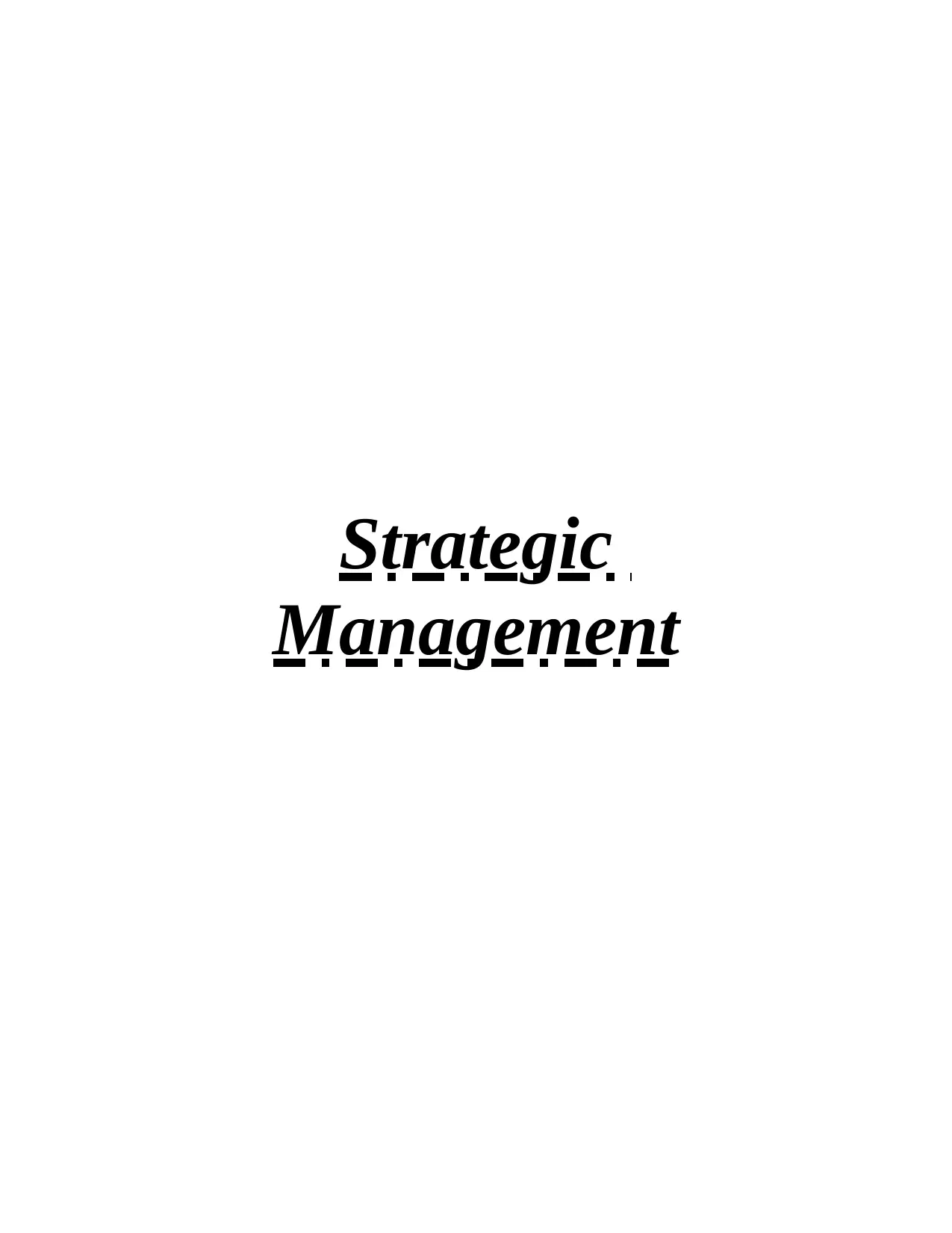
Strategic
Management
Management
Paraphrase This Document
Need a fresh take? Get an instant paraphrase of this document with our AI Paraphraser

Table of Contents
Introduction......................................................................................................................................4
Company overview..........................................................................................................................4
Philosophy of Microsoft.........................................................................................................4
Current Business Scenario......................................................................................................4
TASK 1............................................................................................................................................5
Porter's Five Forces Model.....................................................................................................5
TASK 2............................................................................................................................................8
Porter's Generic Strategies......................................................................................................8
TASK 3..........................................................................................................................................10
Recommendation..................................................................................................................10
Conclusion.....................................................................................................................................11
References......................................................................................................................................12
Introduction......................................................................................................................................4
Company overview..........................................................................................................................4
Philosophy of Microsoft.........................................................................................................4
Current Business Scenario......................................................................................................4
TASK 1............................................................................................................................................5
Porter's Five Forces Model.....................................................................................................5
TASK 2............................................................................................................................................8
Porter's Generic Strategies......................................................................................................8
TASK 3..........................................................................................................................................10
Recommendation..................................................................................................................10
Conclusion.....................................................................................................................................11
References......................................................................................................................................12

Introduction
Strategic management refer to uninterrupted process of organisation which comprises of
planning, monitoring, analysis, assessing and evaluation of entire processes which are needed for
accomplishing objectives of organisation (Doz, 2017). It is crucial for organisation as this allows
them to identify opportunities within future and apply them in processes to acquire better results.
This report is based on Microsoft Corporation which is headquartered within Redmond,
Washington. It is a multinational organisation. This report includes identification and critical
analysis of organisation in terms of strategic management. Different theories have been used
through which Microsoft can execute strategic management effectual.
Company overview
Microsoft Corporation is one of the largest technological organisation in the world which
was founded by Paul Allen and Bill Gates in 1975. They have broad range of operations like
development, manufacturing and sale of computer software, personal computers and electronics.
The organisation has their own market around the world as they are the one who are trusted
mostly by people with respect to performance, reliability and speed.
Philosophy of Microsoft
The mission statement of the organisation aims on reaching worldwide to attain their aim.
Vision of Microsoft is to make businesses as well as people realise complete potential and worth
of products which are being provided by them. Generally, the agenda of organisation is to
empower each individual as well as organisation by which they can effectually achieve more and
develop or evolve further (Grunig, 2013).
Current Business Scenario
At present, Microsoft is most important as well as leading player within electronic
subsectors where other organisations are struggling to make their presence. They have crossed
$100 Billion mark by earning around $110 Billion revenue in year 2018. Organisation has a large
global market and they make effectual use of technologies thereby leads to enhancement in their
capabilities. The different innovative creations and aspects of organisation plays huge role within
competent performance of organisation (Hahn, 2013).
An instance can be taken which depicts performance of Microsoft are LinkedIn, Windows
pro and Surface. Another source of their performance is “Commercial cloud”, for an illustration,
Strategic management refer to uninterrupted process of organisation which comprises of
planning, monitoring, analysis, assessing and evaluation of entire processes which are needed for
accomplishing objectives of organisation (Doz, 2017). It is crucial for organisation as this allows
them to identify opportunities within future and apply them in processes to acquire better results.
This report is based on Microsoft Corporation which is headquartered within Redmond,
Washington. It is a multinational organisation. This report includes identification and critical
analysis of organisation in terms of strategic management. Different theories have been used
through which Microsoft can execute strategic management effectual.
Company overview
Microsoft Corporation is one of the largest technological organisation in the world which
was founded by Paul Allen and Bill Gates in 1975. They have broad range of operations like
development, manufacturing and sale of computer software, personal computers and electronics.
The organisation has their own market around the world as they are the one who are trusted
mostly by people with respect to performance, reliability and speed.
Philosophy of Microsoft
The mission statement of the organisation aims on reaching worldwide to attain their aim.
Vision of Microsoft is to make businesses as well as people realise complete potential and worth
of products which are being provided by them. Generally, the agenda of organisation is to
empower each individual as well as organisation by which they can effectually achieve more and
develop or evolve further (Grunig, 2013).
Current Business Scenario
At present, Microsoft is most important as well as leading player within electronic
subsectors where other organisations are struggling to make their presence. They have crossed
$100 Billion mark by earning around $110 Billion revenue in year 2018. Organisation has a large
global market and they make effectual use of technologies thereby leads to enhancement in their
capabilities. The different innovative creations and aspects of organisation plays huge role within
competent performance of organisation (Hahn, 2013).
An instance can be taken which depicts performance of Microsoft are LinkedIn, Windows
pro and Surface. Another source of their performance is “Commercial cloud”, for an illustration,
⊘ This is a preview!⊘
Do you want full access?
Subscribe today to unlock all pages.

Trusted by 1+ million students worldwide
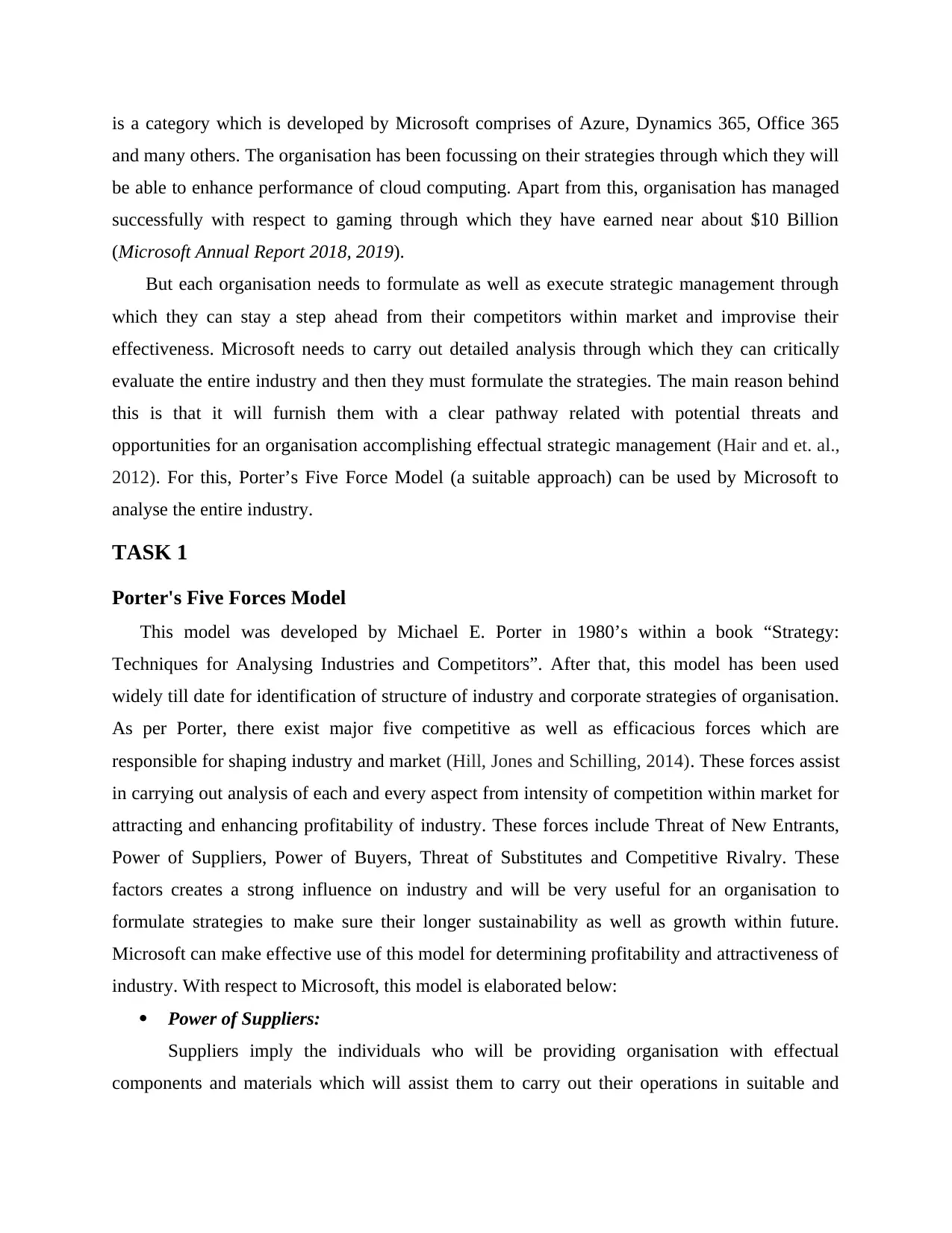
is a category which is developed by Microsoft comprises of Azure, Dynamics 365, Office 365
and many others. The organisation has been focussing on their strategies through which they will
be able to enhance performance of cloud computing. Apart from this, organisation has managed
successfully with respect to gaming through which they have earned near about $10 Billion
(Microsoft Annual Report 2018, 2019).
But each organisation needs to formulate as well as execute strategic management through
which they can stay a step ahead from their competitors within market and improvise their
effectiveness. Microsoft needs to carry out detailed analysis through which they can critically
evaluate the entire industry and then they must formulate the strategies. The main reason behind
this is that it will furnish them with a clear pathway related with potential threats and
opportunities for an organisation accomplishing effectual strategic management (Hair and et. al.,
2012). For this, Porter’s Five Force Model (a suitable approach) can be used by Microsoft to
analyse the entire industry.
TASK 1
Porter's Five Forces Model
This model was developed by Michael E. Porter in 1980’s within a book “Strategy:
Techniques for Analysing Industries and Competitors”. After that, this model has been used
widely till date for identification of structure of industry and corporate strategies of organisation.
As per Porter, there exist major five competitive as well as efficacious forces which are
responsible for shaping industry and market (Hill, Jones and Schilling, 2014). These forces assist
in carrying out analysis of each and every aspect from intensity of competition within market for
attracting and enhancing profitability of industry. These forces include Threat of New Entrants,
Power of Suppliers, Power of Buyers, Threat of Substitutes and Competitive Rivalry. These
factors creates a strong influence on industry and will be very useful for an organisation to
formulate strategies to make sure their longer sustainability as well as growth within future.
Microsoft can make effective use of this model for determining profitability and attractiveness of
industry. With respect to Microsoft, this model is elaborated below:
Power of Suppliers:
Suppliers imply the individuals who will be providing organisation with effectual
components and materials which will assist them to carry out their operations in suitable and
and many others. The organisation has been focussing on their strategies through which they will
be able to enhance performance of cloud computing. Apart from this, organisation has managed
successfully with respect to gaming through which they have earned near about $10 Billion
(Microsoft Annual Report 2018, 2019).
But each organisation needs to formulate as well as execute strategic management through
which they can stay a step ahead from their competitors within market and improvise their
effectiveness. Microsoft needs to carry out detailed analysis through which they can critically
evaluate the entire industry and then they must formulate the strategies. The main reason behind
this is that it will furnish them with a clear pathway related with potential threats and
opportunities for an organisation accomplishing effectual strategic management (Hair and et. al.,
2012). For this, Porter’s Five Force Model (a suitable approach) can be used by Microsoft to
analyse the entire industry.
TASK 1
Porter's Five Forces Model
This model was developed by Michael E. Porter in 1980’s within a book “Strategy:
Techniques for Analysing Industries and Competitors”. After that, this model has been used
widely till date for identification of structure of industry and corporate strategies of organisation.
As per Porter, there exist major five competitive as well as efficacious forces which are
responsible for shaping industry and market (Hill, Jones and Schilling, 2014). These forces assist
in carrying out analysis of each and every aspect from intensity of competition within market for
attracting and enhancing profitability of industry. These forces include Threat of New Entrants,
Power of Suppliers, Power of Buyers, Threat of Substitutes and Competitive Rivalry. These
factors creates a strong influence on industry and will be very useful for an organisation to
formulate strategies to make sure their longer sustainability as well as growth within future.
Microsoft can make effective use of this model for determining profitability and attractiveness of
industry. With respect to Microsoft, this model is elaborated below:
Power of Suppliers:
Suppliers imply the individuals who will be providing organisation with effectual
components and materials which will assist them to carry out their operations in suitable and
Paraphrase This Document
Need a fresh take? Get an instant paraphrase of this document with our AI Paraphraser
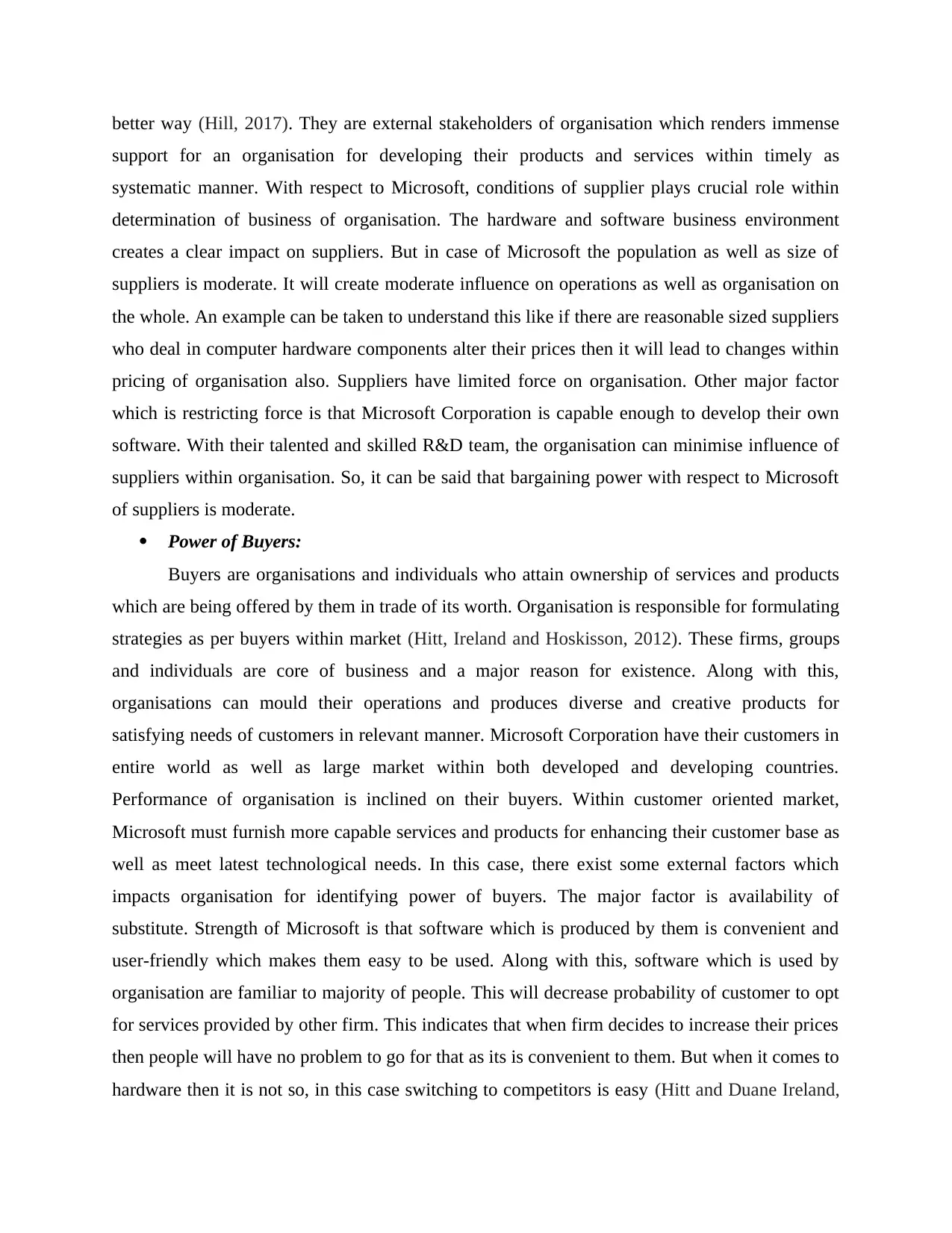
better way (Hill, 2017). They are external stakeholders of organisation which renders immense
support for an organisation for developing their products and services within timely as
systematic manner. With respect to Microsoft, conditions of supplier plays crucial role within
determination of business of organisation. The hardware and software business environment
creates a clear impact on suppliers. But in case of Microsoft the population as well as size of
suppliers is moderate. It will create moderate influence on operations as well as organisation on
the whole. An example can be taken to understand this like if there are reasonable sized suppliers
who deal in computer hardware components alter their prices then it will lead to changes within
pricing of organisation also. Suppliers have limited force on organisation. Other major factor
which is restricting force is that Microsoft Corporation is capable enough to develop their own
software. With their talented and skilled R&D team, the organisation can minimise influence of
suppliers within organisation. So, it can be said that bargaining power with respect to Microsoft
of suppliers is moderate.
Power of Buyers:
Buyers are organisations and individuals who attain ownership of services and products
which are being offered by them in trade of its worth. Organisation is responsible for formulating
strategies as per buyers within market (Hitt, Ireland and Hoskisson, 2012). These firms, groups
and individuals are core of business and a major reason for existence. Along with this,
organisations can mould their operations and produces diverse and creative products for
satisfying needs of customers in relevant manner. Microsoft Corporation have their customers in
entire world as well as large market within both developed and developing countries.
Performance of organisation is inclined on their buyers. Within customer oriented market,
Microsoft must furnish more capable services and products for enhancing their customer base as
well as meet latest technological needs. In this case, there exist some external factors which
impacts organisation for identifying power of buyers. The major factor is availability of
substitute. Strength of Microsoft is that software which is produced by them is convenient and
user-friendly which makes them easy to be used. Along with this, software which is used by
organisation are familiar to majority of people. This will decrease probability of customer to opt
for services provided by other firm. This indicates that when firm decides to increase their prices
then people will have no problem to go for that as its is convenient to them. But when it comes to
hardware then it is not so, in this case switching to competitors is easy (Hitt and Duane Ireland,
support for an organisation for developing their products and services within timely as
systematic manner. With respect to Microsoft, conditions of supplier plays crucial role within
determination of business of organisation. The hardware and software business environment
creates a clear impact on suppliers. But in case of Microsoft the population as well as size of
suppliers is moderate. It will create moderate influence on operations as well as organisation on
the whole. An example can be taken to understand this like if there are reasonable sized suppliers
who deal in computer hardware components alter their prices then it will lead to changes within
pricing of organisation also. Suppliers have limited force on organisation. Other major factor
which is restricting force is that Microsoft Corporation is capable enough to develop their own
software. With their talented and skilled R&D team, the organisation can minimise influence of
suppliers within organisation. So, it can be said that bargaining power with respect to Microsoft
of suppliers is moderate.
Power of Buyers:
Buyers are organisations and individuals who attain ownership of services and products
which are being offered by them in trade of its worth. Organisation is responsible for formulating
strategies as per buyers within market (Hitt, Ireland and Hoskisson, 2012). These firms, groups
and individuals are core of business and a major reason for existence. Along with this,
organisations can mould their operations and produces diverse and creative products for
satisfying needs of customers in relevant manner. Microsoft Corporation have their customers in
entire world as well as large market within both developed and developing countries.
Performance of organisation is inclined on their buyers. Within customer oriented market,
Microsoft must furnish more capable services and products for enhancing their customer base as
well as meet latest technological needs. In this case, there exist some external factors which
impacts organisation for identifying power of buyers. The major factor is availability of
substitute. Strength of Microsoft is that software which is produced by them is convenient and
user-friendly which makes them easy to be used. Along with this, software which is used by
organisation are familiar to majority of people. This will decrease probability of customer to opt
for services provided by other firm. This indicates that when firm decides to increase their prices
then people will have no problem to go for that as its is convenient to them. But when it comes to
hardware then it is not so, in this case switching to competitors is easy (Hitt and Duane Ireland,
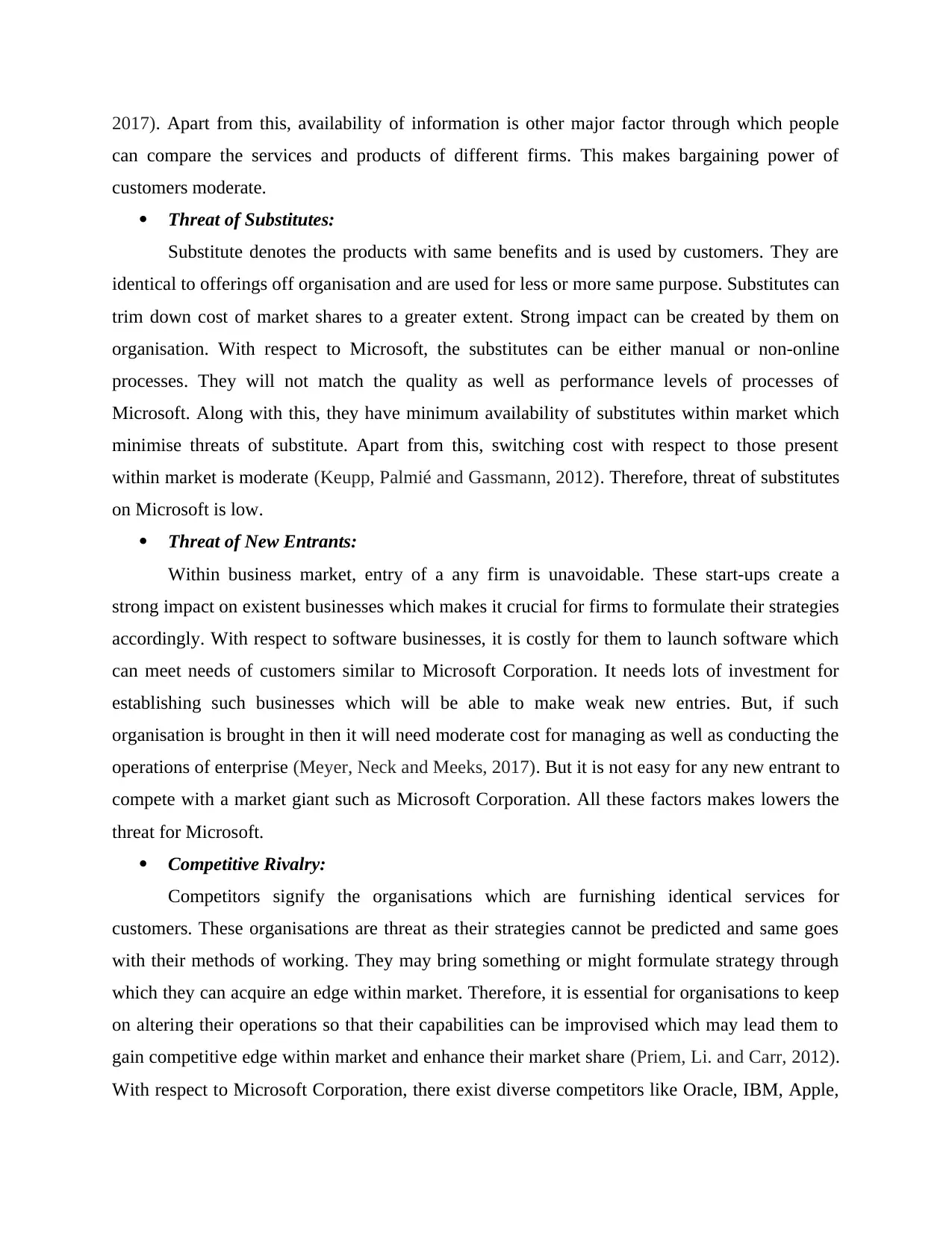
2017). Apart from this, availability of information is other major factor through which people
can compare the services and products of different firms. This makes bargaining power of
customers moderate.
Threat of Substitutes:
Substitute denotes the products with same benefits and is used by customers. They are
identical to offerings off organisation and are used for less or more same purpose. Substitutes can
trim down cost of market shares to a greater extent. Strong impact can be created by them on
organisation. With respect to Microsoft, the substitutes can be either manual or non-online
processes. They will not match the quality as well as performance levels of processes of
Microsoft. Along with this, they have minimum availability of substitutes within market which
minimise threats of substitute. Apart from this, switching cost with respect to those present
within market is moderate (Keupp, Palmié and Gassmann, 2012). Therefore, threat of substitutes
on Microsoft is low.
Threat of New Entrants:
Within business market, entry of a any firm is unavoidable. These start-ups create a
strong impact on existent businesses which makes it crucial for firms to formulate their strategies
accordingly. With respect to software businesses, it is costly for them to launch software which
can meet needs of customers similar to Microsoft Corporation. It needs lots of investment for
establishing such businesses which will be able to make weak new entries. But, if such
organisation is brought in then it will need moderate cost for managing as well as conducting the
operations of enterprise (Meyer, Neck and Meeks, 2017). But it is not easy for any new entrant to
compete with a market giant such as Microsoft Corporation. All these factors makes lowers the
threat for Microsoft.
Competitive Rivalry:
Competitors signify the organisations which are furnishing identical services for
customers. These organisations are threat as their strategies cannot be predicted and same goes
with their methods of working. They may bring something or might formulate strategy through
which they can acquire an edge within market. Therefore, it is essential for organisations to keep
on altering their operations so that their capabilities can be improvised which may lead them to
gain competitive edge within market and enhance their market share (Priem, Li. and Carr, 2012).
With respect to Microsoft Corporation, there exist diverse competitors like Oracle, IBM, Apple,
can compare the services and products of different firms. This makes bargaining power of
customers moderate.
Threat of Substitutes:
Substitute denotes the products with same benefits and is used by customers. They are
identical to offerings off organisation and are used for less or more same purpose. Substitutes can
trim down cost of market shares to a greater extent. Strong impact can be created by them on
organisation. With respect to Microsoft, the substitutes can be either manual or non-online
processes. They will not match the quality as well as performance levels of processes of
Microsoft. Along with this, they have minimum availability of substitutes within market which
minimise threats of substitute. Apart from this, switching cost with respect to those present
within market is moderate (Keupp, Palmié and Gassmann, 2012). Therefore, threat of substitutes
on Microsoft is low.
Threat of New Entrants:
Within business market, entry of a any firm is unavoidable. These start-ups create a
strong impact on existent businesses which makes it crucial for firms to formulate their strategies
accordingly. With respect to software businesses, it is costly for them to launch software which
can meet needs of customers similar to Microsoft Corporation. It needs lots of investment for
establishing such businesses which will be able to make weak new entries. But, if such
organisation is brought in then it will need moderate cost for managing as well as conducting the
operations of enterprise (Meyer, Neck and Meeks, 2017). But it is not easy for any new entrant to
compete with a market giant such as Microsoft Corporation. All these factors makes lowers the
threat for Microsoft.
Competitive Rivalry:
Competitors signify the organisations which are furnishing identical services for
customers. These organisations are threat as their strategies cannot be predicted and same goes
with their methods of working. They may bring something or might formulate strategy through
which they can acquire an edge within market. Therefore, it is essential for organisations to keep
on altering their operations so that their capabilities can be improvised which may lead them to
gain competitive edge within market and enhance their market share (Priem, Li. and Carr, 2012).
With respect to Microsoft Corporation, there exist diverse competitors like Oracle, IBM, Apple,
⊘ This is a preview!⊘
Do you want full access?
Subscribe today to unlock all pages.

Trusted by 1+ million students worldwide
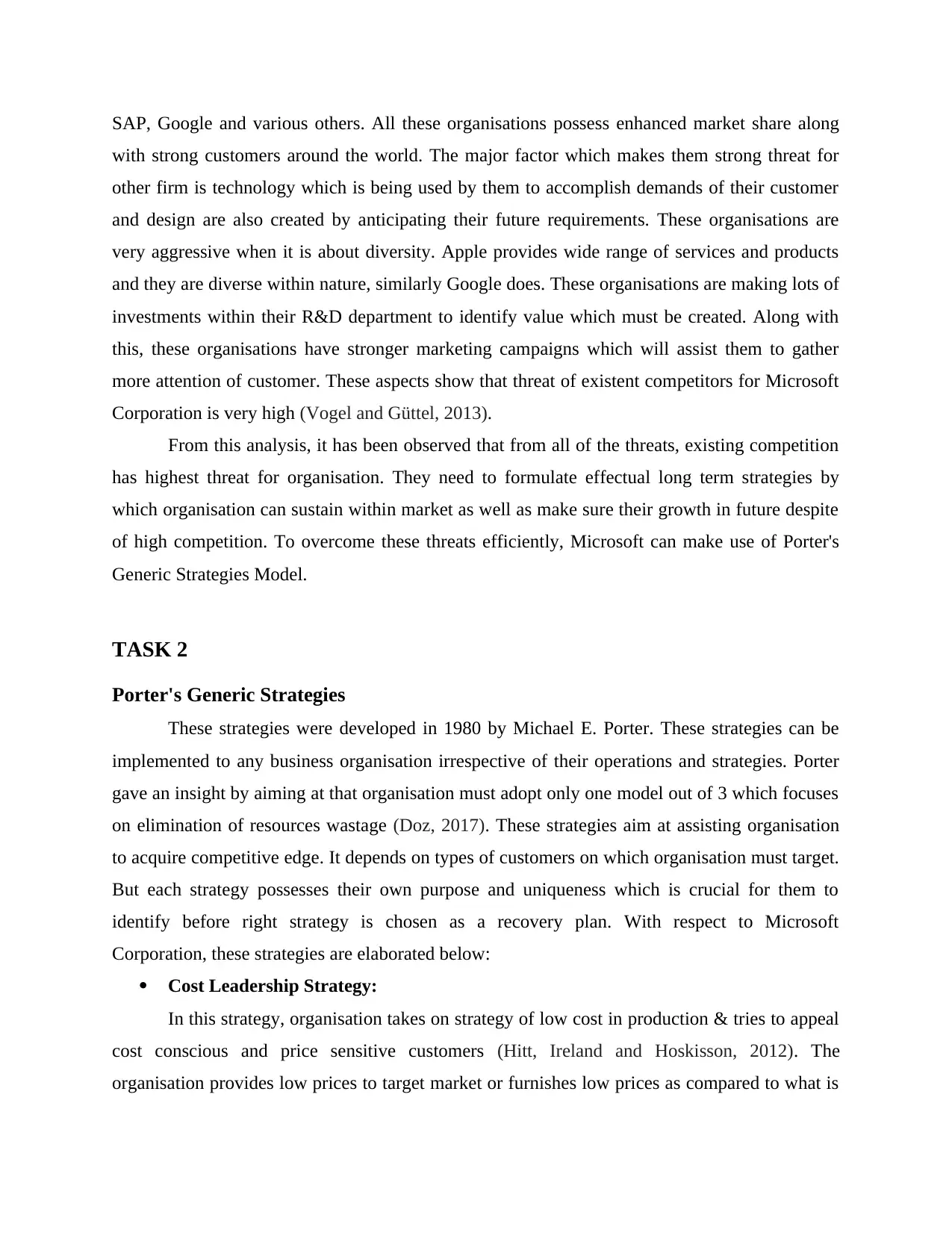
SAP, Google and various others. All these organisations possess enhanced market share along
with strong customers around the world. The major factor which makes them strong threat for
other firm is technology which is being used by them to accomplish demands of their customer
and design are also created by anticipating their future requirements. These organisations are
very aggressive when it is about diversity. Apple provides wide range of services and products
and they are diverse within nature, similarly Google does. These organisations are making lots of
investments within their R&D department to identify value which must be created. Along with
this, these organisations have stronger marketing campaigns which will assist them to gather
more attention of customer. These aspects show that threat of existent competitors for Microsoft
Corporation is very high (Vogel and Güttel, 2013).
From this analysis, it has been observed that from all of the threats, existing competition
has highest threat for organisation. They need to formulate effectual long term strategies by
which organisation can sustain within market as well as make sure their growth in future despite
of high competition. To overcome these threats efficiently, Microsoft can make use of Porter's
Generic Strategies Model.
TASK 2
Porter's Generic Strategies
These strategies were developed in 1980 by Michael E. Porter. These strategies can be
implemented to any business organisation irrespective of their operations and strategies. Porter
gave an insight by aiming at that organisation must adopt only one model out of 3 which focuses
on elimination of resources wastage (Doz, 2017). These strategies aim at assisting organisation
to acquire competitive edge. It depends on types of customers on which organisation must target.
But each strategy possesses their own purpose and uniqueness which is crucial for them to
identify before right strategy is chosen as a recovery plan. With respect to Microsoft
Corporation, these strategies are elaborated below:
Cost Leadership Strategy:
In this strategy, organisation takes on strategy of low cost in production & tries to appeal
cost conscious and price sensitive customers (Hitt, Ireland and Hoskisson, 2012). The
organisation provides low prices to target market or furnishes low prices as compared to what is
with strong customers around the world. The major factor which makes them strong threat for
other firm is technology which is being used by them to accomplish demands of their customer
and design are also created by anticipating their future requirements. These organisations are
very aggressive when it is about diversity. Apple provides wide range of services and products
and they are diverse within nature, similarly Google does. These organisations are making lots of
investments within their R&D department to identify value which must be created. Along with
this, these organisations have stronger marketing campaigns which will assist them to gather
more attention of customer. These aspects show that threat of existent competitors for Microsoft
Corporation is very high (Vogel and Güttel, 2013).
From this analysis, it has been observed that from all of the threats, existing competition
has highest threat for organisation. They need to formulate effectual long term strategies by
which organisation can sustain within market as well as make sure their growth in future despite
of high competition. To overcome these threats efficiently, Microsoft can make use of Porter's
Generic Strategies Model.
TASK 2
Porter's Generic Strategies
These strategies were developed in 1980 by Michael E. Porter. These strategies can be
implemented to any business organisation irrespective of their operations and strategies. Porter
gave an insight by aiming at that organisation must adopt only one model out of 3 which focuses
on elimination of resources wastage (Doz, 2017). These strategies aim at assisting organisation
to acquire competitive edge. It depends on types of customers on which organisation must target.
But each strategy possesses their own purpose and uniqueness which is crucial for them to
identify before right strategy is chosen as a recovery plan. With respect to Microsoft
Corporation, these strategies are elaborated below:
Cost Leadership Strategy:
In this strategy, organisation takes on strategy of low cost in production & tries to appeal
cost conscious and price sensitive customers (Hitt, Ireland and Hoskisson, 2012). The
organisation provides low prices to target market or furnishes low prices as compared to what is
Paraphrase This Document
Need a fresh take? Get an instant paraphrase of this document with our AI Paraphraser
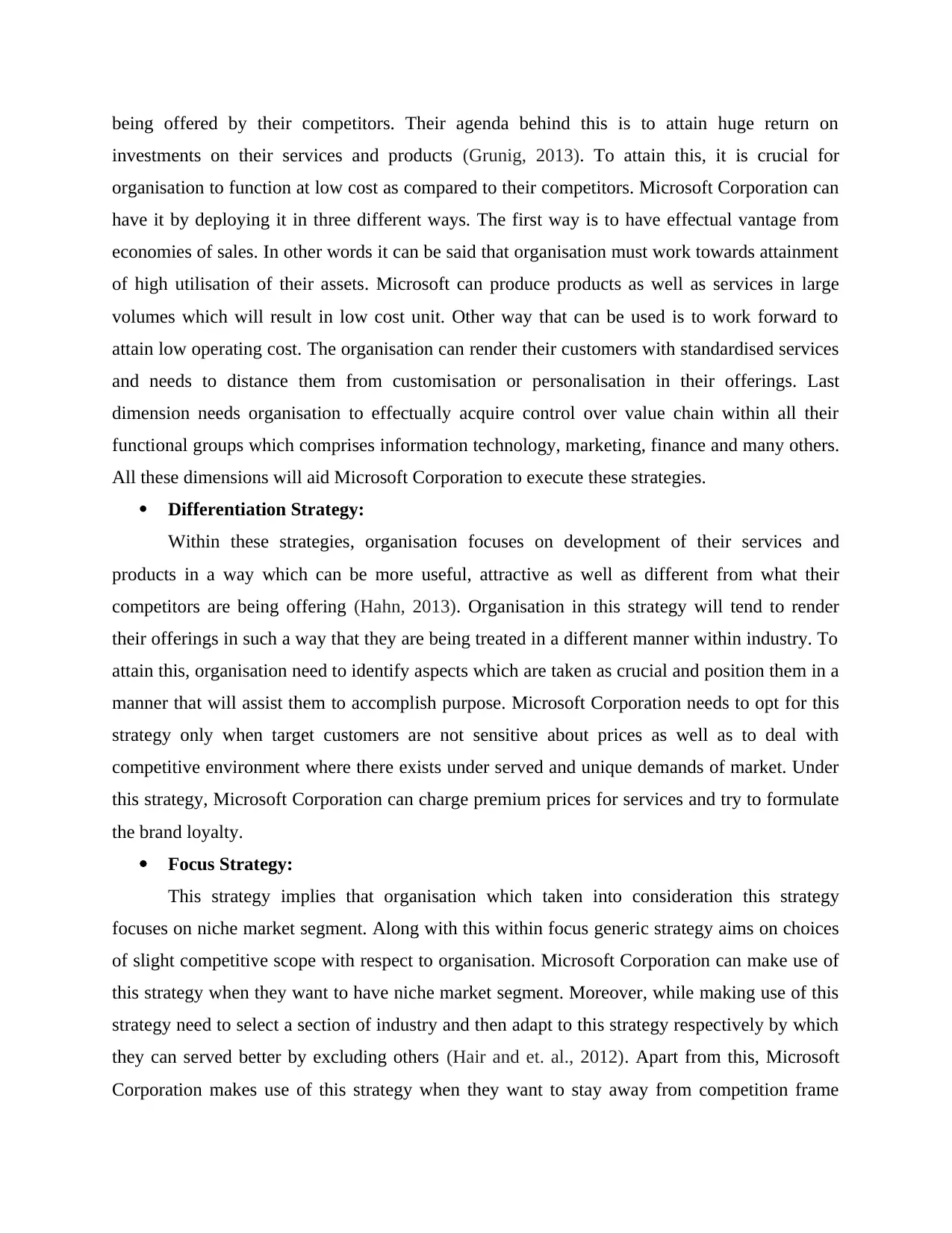
being offered by their competitors. Their agenda behind this is to attain huge return on
investments on their services and products (Grunig, 2013). To attain this, it is crucial for
organisation to function at low cost as compared to their competitors. Microsoft Corporation can
have it by deploying it in three different ways. The first way is to have effectual vantage from
economies of sales. In other words it can be said that organisation must work towards attainment
of high utilisation of their assets. Microsoft can produce products as well as services in large
volumes which will result in low cost unit. Other way that can be used is to work forward to
attain low operating cost. The organisation can render their customers with standardised services
and needs to distance them from customisation or personalisation in their offerings. Last
dimension needs organisation to effectually acquire control over value chain within all their
functional groups which comprises information technology, marketing, finance and many others.
All these dimensions will aid Microsoft Corporation to execute these strategies.
Differentiation Strategy:
Within these strategies, organisation focuses on development of their services and
products in a way which can be more useful, attractive as well as different from what their
competitors are being offering (Hahn, 2013). Organisation in this strategy will tend to render
their offerings in such a way that they are being treated in a different manner within industry. To
attain this, organisation need to identify aspects which are taken as crucial and position them in a
manner that will assist them to accomplish purpose. Microsoft Corporation needs to opt for this
strategy only when target customers are not sensitive about prices as well as to deal with
competitive environment where there exists under served and unique demands of market. Under
this strategy, Microsoft Corporation can charge premium prices for services and try to formulate
the brand loyalty.
Focus Strategy:
This strategy implies that organisation which taken into consideration this strategy
focuses on niche market segment. Along with this within focus generic strategy aims on choices
of slight competitive scope with respect to organisation. Microsoft Corporation can make use of
this strategy when they want to have niche market segment. Moreover, while making use of this
strategy need to select a section of industry and then adapt to this strategy respectively by which
they can served better by excluding others (Hair and et. al., 2012). Apart from this, Microsoft
Corporation makes use of this strategy when they want to stay away from competition frame
investments on their services and products (Grunig, 2013). To attain this, it is crucial for
organisation to function at low cost as compared to their competitors. Microsoft Corporation can
have it by deploying it in three different ways. The first way is to have effectual vantage from
economies of sales. In other words it can be said that organisation must work towards attainment
of high utilisation of their assets. Microsoft can produce products as well as services in large
volumes which will result in low cost unit. Other way that can be used is to work forward to
attain low operating cost. The organisation can render their customers with standardised services
and needs to distance them from customisation or personalisation in their offerings. Last
dimension needs organisation to effectually acquire control over value chain within all their
functional groups which comprises information technology, marketing, finance and many others.
All these dimensions will aid Microsoft Corporation to execute these strategies.
Differentiation Strategy:
Within these strategies, organisation focuses on development of their services and
products in a way which can be more useful, attractive as well as different from what their
competitors are being offering (Hahn, 2013). Organisation in this strategy will tend to render
their offerings in such a way that they are being treated in a different manner within industry. To
attain this, organisation need to identify aspects which are taken as crucial and position them in a
manner that will assist them to accomplish purpose. Microsoft Corporation needs to opt for this
strategy only when target customers are not sensitive about prices as well as to deal with
competitive environment where there exists under served and unique demands of market. Under
this strategy, Microsoft Corporation can charge premium prices for services and try to formulate
the brand loyalty.
Focus Strategy:
This strategy implies that organisation which taken into consideration this strategy
focuses on niche market segment. Along with this within focus generic strategy aims on choices
of slight competitive scope with respect to organisation. Microsoft Corporation can make use of
this strategy when they want to have niche market segment. Moreover, while making use of this
strategy need to select a section of industry and then adapt to this strategy respectively by which
they can served better by excluding others (Hair and et. al., 2012). Apart from this, Microsoft
Corporation makes use of this strategy when they want to stay away from competition frame
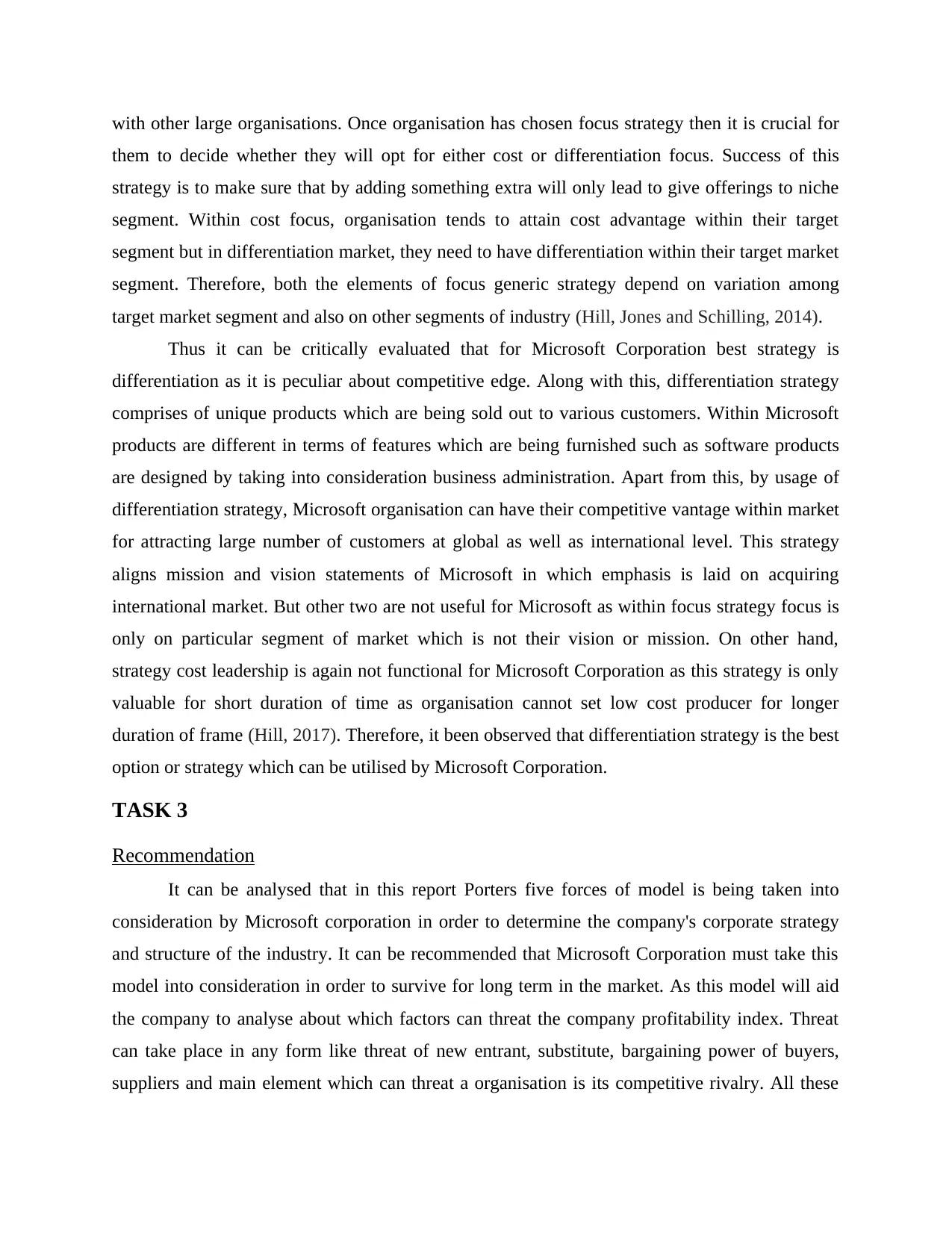
with other large organisations. Once organisation has chosen focus strategy then it is crucial for
them to decide whether they will opt for either cost or differentiation focus. Success of this
strategy is to make sure that by adding something extra will only lead to give offerings to niche
segment. Within cost focus, organisation tends to attain cost advantage within their target
segment but in differentiation market, they need to have differentiation within their target market
segment. Therefore, both the elements of focus generic strategy depend on variation among
target market segment and also on other segments of industry (Hill, Jones and Schilling, 2014).
Thus it can be critically evaluated that for Microsoft Corporation best strategy is
differentiation as it is peculiar about competitive edge. Along with this, differentiation strategy
comprises of unique products which are being sold out to various customers. Within Microsoft
products are different in terms of features which are being furnished such as software products
are designed by taking into consideration business administration. Apart from this, by usage of
differentiation strategy, Microsoft organisation can have their competitive vantage within market
for attracting large number of customers at global as well as international level. This strategy
aligns mission and vision statements of Microsoft in which emphasis is laid on acquiring
international market. But other two are not useful for Microsoft as within focus strategy focus is
only on particular segment of market which is not their vision or mission. On other hand,
strategy cost leadership is again not functional for Microsoft Corporation as this strategy is only
valuable for short duration of time as organisation cannot set low cost producer for longer
duration of frame (Hill, 2017). Therefore, it been observed that differentiation strategy is the best
option or strategy which can be utilised by Microsoft Corporation.
TASK 3
Recommendation
It can be analysed that in this report Porters five forces of model is being taken into
consideration by Microsoft corporation in order to determine the company's corporate strategy
and structure of the industry. It can be recommended that Microsoft Corporation must take this
model into consideration in order to survive for long term in the market. As this model will aid
the company to analyse about which factors can threat the company profitability index. Threat
can take place in any form like threat of new entrant, substitute, bargaining power of buyers,
suppliers and main element which can threat a organisation is its competitive rivalry. All these
them to decide whether they will opt for either cost or differentiation focus. Success of this
strategy is to make sure that by adding something extra will only lead to give offerings to niche
segment. Within cost focus, organisation tends to attain cost advantage within their target
segment but in differentiation market, they need to have differentiation within their target market
segment. Therefore, both the elements of focus generic strategy depend on variation among
target market segment and also on other segments of industry (Hill, Jones and Schilling, 2014).
Thus it can be critically evaluated that for Microsoft Corporation best strategy is
differentiation as it is peculiar about competitive edge. Along with this, differentiation strategy
comprises of unique products which are being sold out to various customers. Within Microsoft
products are different in terms of features which are being furnished such as software products
are designed by taking into consideration business administration. Apart from this, by usage of
differentiation strategy, Microsoft organisation can have their competitive vantage within market
for attracting large number of customers at global as well as international level. This strategy
aligns mission and vision statements of Microsoft in which emphasis is laid on acquiring
international market. But other two are not useful for Microsoft as within focus strategy focus is
only on particular segment of market which is not their vision or mission. On other hand,
strategy cost leadership is again not functional for Microsoft Corporation as this strategy is only
valuable for short duration of time as organisation cannot set low cost producer for longer
duration of frame (Hill, 2017). Therefore, it been observed that differentiation strategy is the best
option or strategy which can be utilised by Microsoft Corporation.
TASK 3
Recommendation
It can be analysed that in this report Porters five forces of model is being taken into
consideration by Microsoft corporation in order to determine the company's corporate strategy
and structure of the industry. It can be recommended that Microsoft Corporation must take this
model into consideration in order to survive for long term in the market. As this model will aid
the company to analyse about which factors can threat the company profitability index. Threat
can take place in any form like threat of new entrant, substitute, bargaining power of buyers,
suppliers and main element which can threat a organisation is its competitive rivalry. All these
⊘ This is a preview!⊘
Do you want full access?
Subscribe today to unlock all pages.

Trusted by 1+ million students worldwide
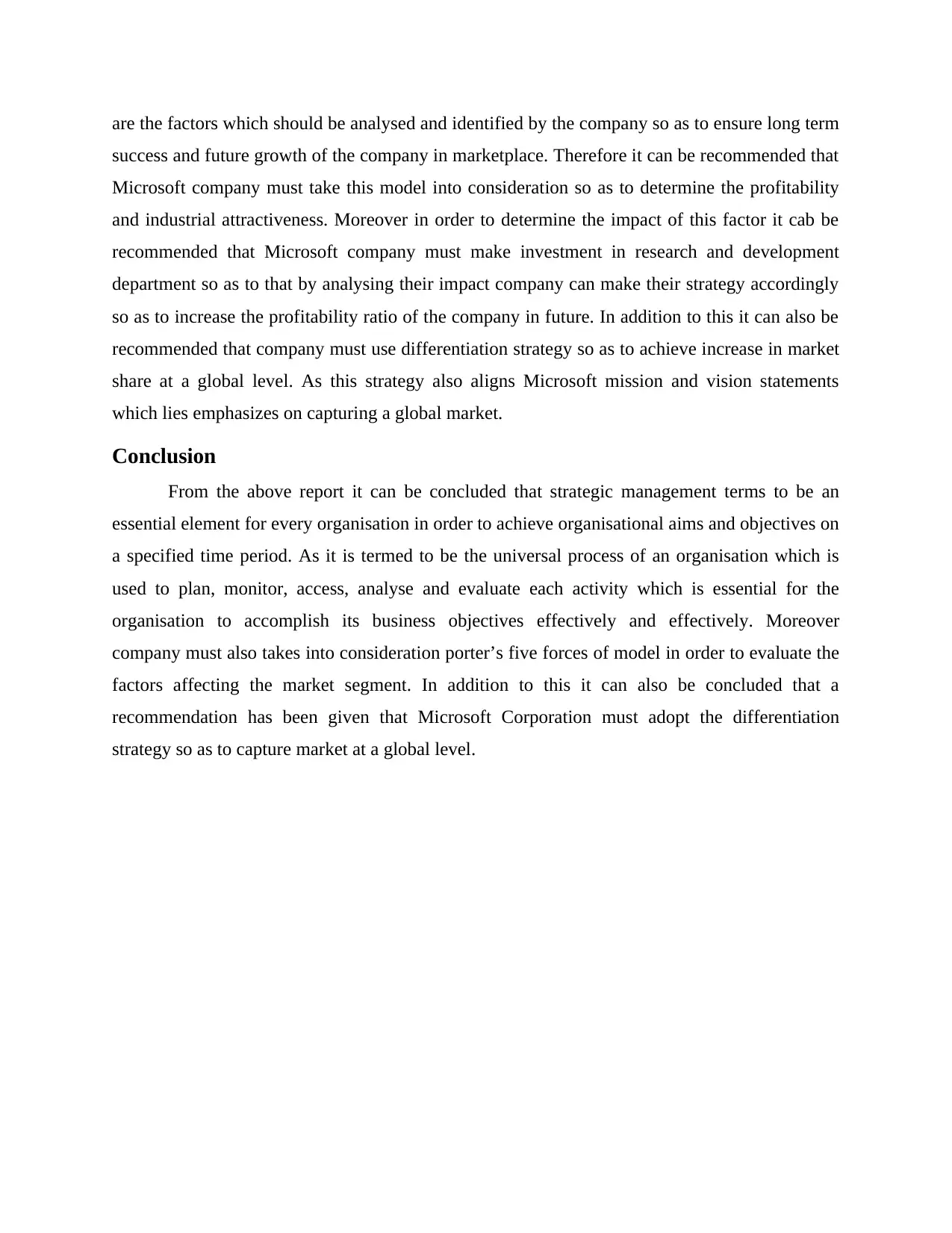
are the factors which should be analysed and identified by the company so as to ensure long term
success and future growth of the company in marketplace. Therefore it can be recommended that
Microsoft company must take this model into consideration so as to determine the profitability
and industrial attractiveness. Moreover in order to determine the impact of this factor it cab be
recommended that Microsoft company must make investment in research and development
department so as to that by analysing their impact company can make their strategy accordingly
so as to increase the profitability ratio of the company in future. In addition to this it can also be
recommended that company must use differentiation strategy so as to achieve increase in market
share at a global level. As this strategy also aligns Microsoft mission and vision statements
which lies emphasizes on capturing a global market.
Conclusion
From the above report it can be concluded that strategic management terms to be an
essential element for every organisation in order to achieve organisational aims and objectives on
a specified time period. As it is termed to be the universal process of an organisation which is
used to plan, monitor, access, analyse and evaluate each activity which is essential for the
organisation to accomplish its business objectives effectively and effectively. Moreover
company must also takes into consideration porter’s five forces of model in order to evaluate the
factors affecting the market segment. In addition to this it can also be concluded that a
recommendation has been given that Microsoft Corporation must adopt the differentiation
strategy so as to capture market at a global level.
success and future growth of the company in marketplace. Therefore it can be recommended that
Microsoft company must take this model into consideration so as to determine the profitability
and industrial attractiveness. Moreover in order to determine the impact of this factor it cab be
recommended that Microsoft company must make investment in research and development
department so as to that by analysing their impact company can make their strategy accordingly
so as to increase the profitability ratio of the company in future. In addition to this it can also be
recommended that company must use differentiation strategy so as to achieve increase in market
share at a global level. As this strategy also aligns Microsoft mission and vision statements
which lies emphasizes on capturing a global market.
Conclusion
From the above report it can be concluded that strategic management terms to be an
essential element for every organisation in order to achieve organisational aims and objectives on
a specified time period. As it is termed to be the universal process of an organisation which is
used to plan, monitor, access, analyse and evaluate each activity which is essential for the
organisation to accomplish its business objectives effectively and effectively. Moreover
company must also takes into consideration porter’s five forces of model in order to evaluate the
factors affecting the market segment. In addition to this it can also be concluded that a
recommendation has been given that Microsoft Corporation must adopt the differentiation
strategy so as to capture market at a global level.
Paraphrase This Document
Need a fresh take? Get an instant paraphrase of this document with our AI Paraphraser

References
Books and Journals
Doz, Y. L., 2017. Strategic management in multinational companies. In International Business
(pp. 229-248). Routledge.
Grunig, J. E., 2013. Furnishing the Edifice: Ongoing Research on Public Relations as a Strategic
Management Function. In Public Relations and Communication Management (pp. 41-
66). Routledge.
Hahn, R., 2013. ISO 26000 and the standardization of strategic management processes for
sustainability and corporate social responsibility. Business Strategy and the
Environment. 22(7). pp.442-455.
Hair, J. F. And et. al., 2012. The use of partial least squares structural equation modeling in
strategic management research: a review of past practices and recommendations for
future applications. Long range planning. 45(5-6). pp.320-340.
Hill, C. W., Jones, G. R. and Schilling, M. A., 2014. Strategic management: theory: an
integrated approach. Cengage Learning.
Hill, T., 2017. Manufacturing strategy: the strategic management of the manufacturing function.
Macmillan International Higher Education.
Hitt, M. A., Ireland, R. D. and Hoskisson, R. E., 2012. Strategic management cases:
competitiveness and globalization. Cengage Learning.
Hitt, M. and Duane Ireland, R., 2017. The intersection of entrepreneurship and strategic
management research. The Blackwell handbook of entrepreneurship, pp.45-63.
Keupp, M. M., Palmié, M. and Gassmann, O., 2012. The strategic management of innovation: A
systematic review and paths for future research. International Journal of Management
Reviews. 14(4). pp.367-390.
Meyer, G. D., Neck, H. M. and Meeks, M. D., 2017. The entrepreneurship‐strategic management
interface. Strategic entrepreneurship: Creating a new mindset. pp.17-44.
Priem, R. L., Li, S. and Carr, J. C., 2012. Insights and new directions from demand-side
approaches to technology innovation, entrepreneurship, and strategic management
research. Journal of management. 38(1). pp.346-374.
Vogel, R. and Güttel, W. H., 2013. The dynamic capability view in strategic management: A
bibliometric review. International Journal of Management Reviews. 15(4). pp.426-446.
Online
Microsoft Annual Report 2018. 2019. [Online]. Available Through:
<https://www.microsoft.com/en-us/annualreports/ar2018/annualreport/>
Books and Journals
Doz, Y. L., 2017. Strategic management in multinational companies. In International Business
(pp. 229-248). Routledge.
Grunig, J. E., 2013. Furnishing the Edifice: Ongoing Research on Public Relations as a Strategic
Management Function. In Public Relations and Communication Management (pp. 41-
66). Routledge.
Hahn, R., 2013. ISO 26000 and the standardization of strategic management processes for
sustainability and corporate social responsibility. Business Strategy and the
Environment. 22(7). pp.442-455.
Hair, J. F. And et. al., 2012. The use of partial least squares structural equation modeling in
strategic management research: a review of past practices and recommendations for
future applications. Long range planning. 45(5-6). pp.320-340.
Hill, C. W., Jones, G. R. and Schilling, M. A., 2014. Strategic management: theory: an
integrated approach. Cengage Learning.
Hill, T., 2017. Manufacturing strategy: the strategic management of the manufacturing function.
Macmillan International Higher Education.
Hitt, M. A., Ireland, R. D. and Hoskisson, R. E., 2012. Strategic management cases:
competitiveness and globalization. Cengage Learning.
Hitt, M. and Duane Ireland, R., 2017. The intersection of entrepreneurship and strategic
management research. The Blackwell handbook of entrepreneurship, pp.45-63.
Keupp, M. M., Palmié, M. and Gassmann, O., 2012. The strategic management of innovation: A
systematic review and paths for future research. International Journal of Management
Reviews. 14(4). pp.367-390.
Meyer, G. D., Neck, H. M. and Meeks, M. D., 2017. The entrepreneurship‐strategic management
interface. Strategic entrepreneurship: Creating a new mindset. pp.17-44.
Priem, R. L., Li, S. and Carr, J. C., 2012. Insights and new directions from demand-side
approaches to technology innovation, entrepreneurship, and strategic management
research. Journal of management. 38(1). pp.346-374.
Vogel, R. and Güttel, W. H., 2013. The dynamic capability view in strategic management: A
bibliometric review. International Journal of Management Reviews. 15(4). pp.426-446.
Online
Microsoft Annual Report 2018. 2019. [Online]. Available Through:
<https://www.microsoft.com/en-us/annualreports/ar2018/annualreport/>
1 out of 11
Related Documents
Your All-in-One AI-Powered Toolkit for Academic Success.
+13062052269
info@desklib.com
Available 24*7 on WhatsApp / Email
![[object Object]](/_next/static/media/star-bottom.7253800d.svg)
Unlock your academic potential
Copyright © 2020–2025 A2Z Services. All Rights Reserved. Developed and managed by ZUCOL.





